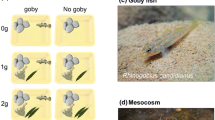Abstract
Using litter bag experiments in the Fraser River estuary in British Columbia, we tested for differences in the relative decomposition rates between leaves of purple loosestrife (Lythrum salicaria), an introduced exotic and a native sedge (Carex lyngbyei). The difference in the mean decay rate coefficient for the two species was significantly defferent (p<0.01) and the coefficient for purple loosestrife (0.0110 d−1) was nearly four times higher than for Lyngbyei's sedge (0.0028 d−1). This is the first estimate of the decay rate coefficient for purple loosestrife from an estuary. The rapid decay rate of loosestrife leaves suggests that they supply detritus to the ecosystem in autumn whereas the much slower decay rate of sedge implies that it supplies detritus throughout the winter and early spring. Consumer organisms important in juvenile salmon food webs appear to be adapted to take advantage of the detritus provided in these seasons. The findings have implications for habitat management because purple loosestrife has recently invaded estuaries of the northeast Pacific and may be outcompeting native sedges important in detrital-based food webs.
Similar content being viewed by others
Literature Cited
Adams, M. A. 1993. Discussion paper: Purple loosestrife (Lythrum salicaria) in the Fraser River Estuary Management Program. Technical Report H-93-01. Fraser River Estuary Program Office. New Westminster, British Columbia.
Ages, A. 1988. The salinity intrusion in the Fraser River: Time series of salinities, temperatures, and currents 1978, 1979.Canadian Data Report Hydrography and Ocean Sciences 66: 187 p.
Brown, T. J., T. R. Whitehouse, and C. D. Levings 1989. Beach seine data from the Fraser River at the North Arm, Main Arm and Agassiz during 1987–88.Canadian Data Report of Fisheries and Aquatic Sciences 737: 134 p.
Canadian Tide and Current Tables. 1993 Volume 5, Juan de Fuca Strait and Strait of Georgia. Department of Fisheries and Oceans. Ottawa, Ontario.
Carey, J. H. 1990. The influence of a salt wedge and tidal flow dynamics on contaminant pathways in the Fraser River estuary, British Columbia, p. 203–208.In W. Michaelis (ed.), Coastal and Estuarine Studies No. 36. Estuarine Water Quality Management. Springer-Verlag, New York.
Emery, S. L. andJ. A. Perry. 1996. Decomposition rates and phosphorus concentrations in purple loosestrife (Lythrum salicaria) and cattail (Typha spp.) in fourteen Minnesota wetlands.Hydrobiologia 323:129–138.
Findlay, S., M. L. Pace, D. Lints, andK. Hoive 1992. Bacterial metabolism of organic carbon in the tidal freshwater Hudson Estuary.Marine Ecology Progress Series 89:147–153.
Jenny, H., S. P. Gesse, andF. T. Bingham. 1949 Comparative study of decomposition rates of organic matter in temperate and tropical regions.Soil Science 69:419–432.
Kistritz, R. V., K. J. Hall, andI. Yesaki. 1983. Productivity, detritus flux, and nutrient cycling in aCarex lyngbyei tidal marsh.Estuaries 6:227–237.
Kistritz, R. U. andI. Yesaki. 1979. Primary production, detritus flux, and nutrient cycling in a sedge marsh, Fraser River estuary. Technical Report 17, Westwater Research Centre, University of British Columbia, Vancouver, British Columbia.
MacDonald, J. S., R. U. Kistritz, and M. Farrell. 1990. An examination of the effects of slough habitat reclamation in the lower Fraser River, British Columbia: Detrital and invertebrate flux, rearing and diets of juvenile salmon.Canadian Technical Report of Fisheries and Aquatic Sciences 1731: 71 p.
Malecki, R. A., B. Blossey, S. D. Hight, D. Schroeder, L. T. Kok, andJ. R. Coulson. 1993. Biological control of purple loosestrife.BioScience 43:680–686.
Moody, A. 1978. Emergent vegetation of the southern Fraser Delta foreshore M.S. Thesis, University of British Columbia, British columbia.
Northcote, T. G. and P. A. Larkin. 1989. The Fraser River: A major salmonine production system.In D. P. Dodge (ed.), Proceedings of the International Large River Symposium.Canadian Special Publications of Fisheries and Aquatic Sciences 106: 172–204.
Olsen, J. S. 1963. Energy storage and the balance of producers and decomposers in ecological systems.Ecology 44:322–331.
Petersen, R. C. andK. W. Cummins. 1974. Leaf proceesing in a woodland stream.Freshwater Biology 4:343–368.
Pomeroy, W. M. andC. D. Levings. 1980. Association and feeding relationships betweenEogammarus confervicolus (Stimpson) (Amphipoda, Gammaridae) and benthic algae on Sturgeon and Roberts Bank, Fraser River estuary.Canadian Journal of Fisheries and Aquatic Sciences 37:1–10.
Richardson, J. S. 1991. Seasonal food limitation of detritivores in a montane stream: An experimental test.Ecology 72: 873–887.
Richardson, J. S. 1992. Food, microhabitat or both? Macroinvertebrate use of leaf accumulation in a montane stream.Freshwater Biology 27: 169–176.
SAS (Statistical Analysis Studies Institute). 1985. SAS Users Guide: Basics, Version 5 Edition. SAS Institute Inc., Cary, North Carolina.
Sibert, J. R. 1982. Roles for detritus in complementing productivity of coastal systems p. 207–214.In L. M. Srivastava (ed.), Synthetic and Degradation Processes in Marine Macrophytes. Walter de Gruyter, New York.
Sibert, J. R., T. J. Brown, M. C. Healey, B. A. Kask, andR. J. Naiman. 1977. Detritus-based food webs: exploitation by juvenile chum salmon (Oncorcynchus keta)Science 196:649–650.
Stanhope, M. J. andC. D. Levings. 1985. Growth and production ofEogammarus confervicolus (Amphipoda: Anisogammaridae) at a log storage site and in areas of undisturbed habitat within the Squamish estuary, British Columbia.Canadian Journal of Fisheries and Aquatic Sciences 42: 1733–1740.
Stronach, J. 1995. An analysis of plant and benthic invertebrate communities in marshes on the lower Fraser River. Prepared for Department of Fisheries and Oceans by Seaconsult Marine Research Ltd. Vancouver, British Columbia.
Webster J. R. andE. F. Benfield. 1986. Vascular plant breakdown in freshwater systems.Annual Review Ecology Systematics 17:567–594.
Author information
Authors and Affiliations
Corresponding author
Rights and permissions
About this article
Cite this article
Grout, J.A., Levings, C.D. & Richardson, J.S. Decomposition rates of purple loosestrife (Lythrum salicaria) and Lyngbyei’s sedge (Carex lyngbyei) in the Fraser River estuary. Estuaries 20, 96–102 (1997). https://doi.org/10.2307/1352723
Issue Date:
DOI: https://doi.org/10.2307/1352723




